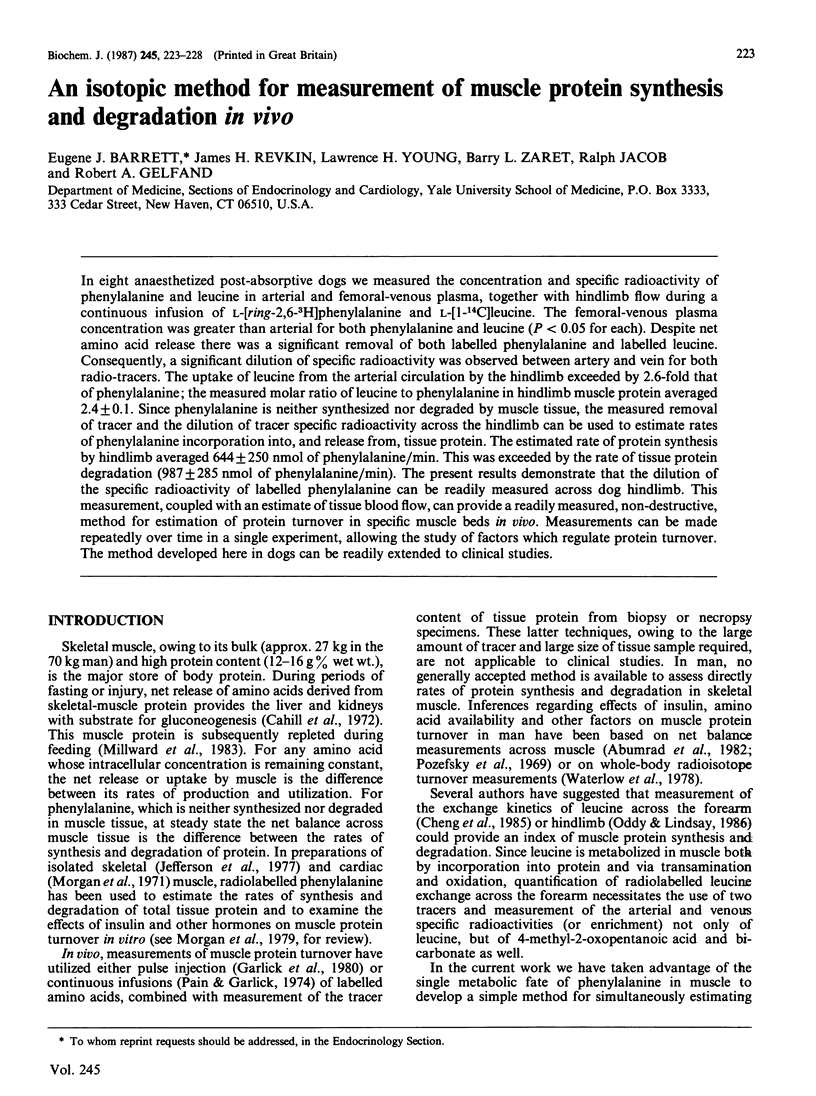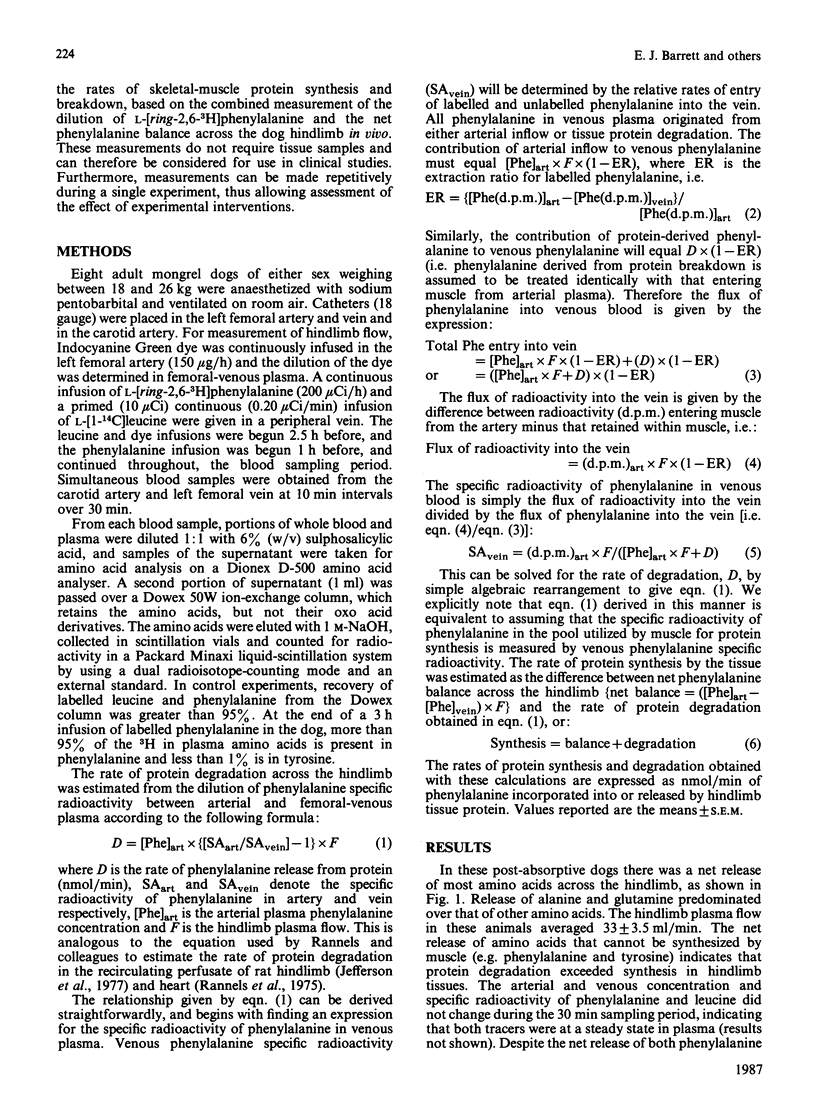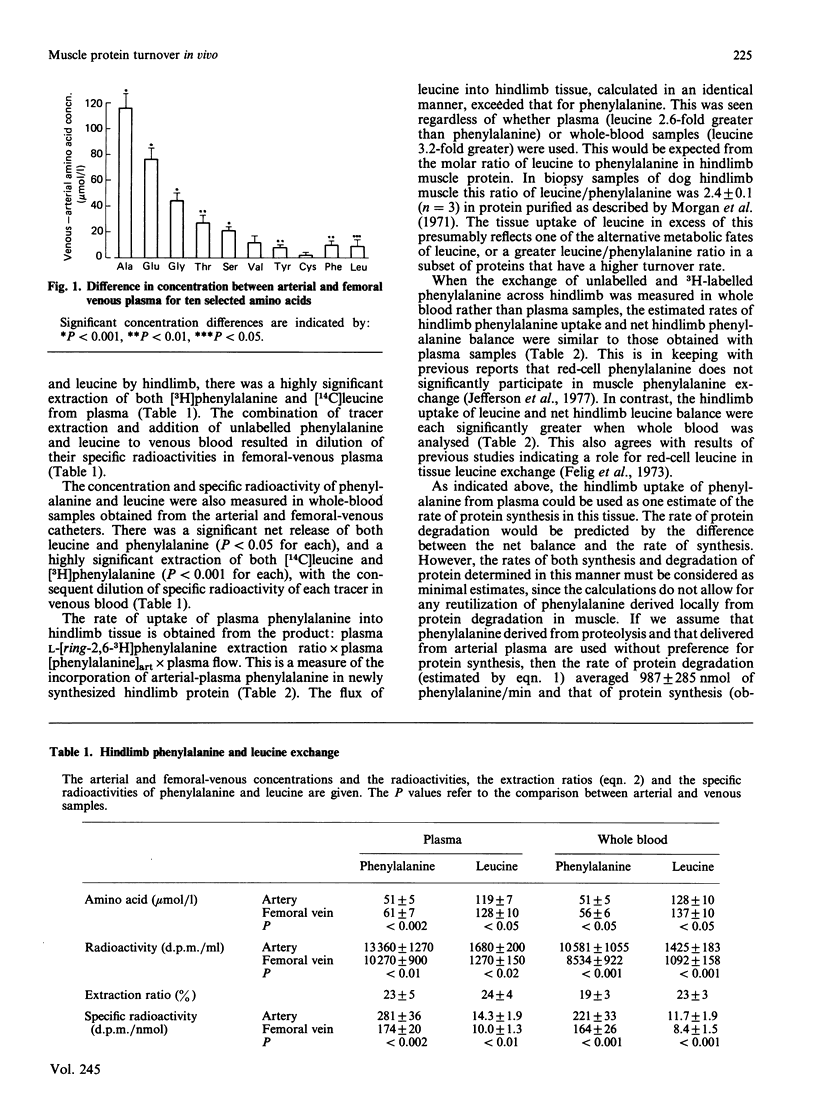Abstract
In eight anaesthetized post-absorptive dogs we measured the concentration and specific radioactivity of phenylalanine and leucine in arterial and femoral-venous plasma, together with hindlimb flow during a continuous infusion of L-[ring-2,6-3H]phenylalanine and [1-14C]leucine. The femoral-venous plasma concentration was greater than arterial for both phenylalanine and leucine (P less than 0.05 for each). Despite net amino acid release there was a significant removal of both labelled phenylalanine and labelled leucine. Consequently, a significant dilution of specific radioactivity was observed between artery and vein for both radio-tracers. The uptake of leucine from the arterial circulation by the hindlimb exceeded by 2.6-fold that of phenylalanine; the measured molar ratio of leucine to phenylalanine in hindlimb muscle protein averaged 2.4 +/- 0.1. Since phenylalanine is neither synthesized nor degraded by muscle tissue, the measured removal of tracer and the dilution of tracer specific radioactivity across the hindlimb can be used to estimate rates of phenylalanine incorporation into, and release from, tissue protein. The estimated rate of protein synthesis by hindlimb averaged 644 +/- 250 nmol of phenylalanine/min. This was exceeded by the rate of tissue protein degradation (987 +/- 285 nmol of phenylalanine/min). The present results demonstrate that the dilution of the specific radioactivity of labelled phenylalanine can be readily measured across dog hindlimb. This measurement, coupled with an estimate of tissue blood flow, can provide a readily measured, non-destructive, method for estimation of protein turnover in specific muscle beds in vivo. Measurements can be made repeatedly over time in a single experiment, allowing the study of factors which regulate protein turnover. The method developed here in dogs can be readily extended to clinical studies.
Full text
PDF





Selected References
These references are in PubMed. This may not be the complete list of references from this article.
- Abumrad N. N., Rabin D., Wise K. L., Lacy W. W. The disposal of an intravenously administered amino acid load across the human forearm. Metabolism. 1982 May;31(5):463–470. doi: 10.1016/0026-0495(82)90235-9. [DOI] [PubMed] [Google Scholar]
- Cheng K. N., Dworzak F., Ford G. C., Rennie M. J., Halliday D. Direct determination of leucine metabolism and protein breakdown in humans using L-[1-13C, 15N]-leucine and the forearm model. Eur J Clin Invest. 1985 Dec;15(6):349–354. doi: 10.1111/j.1365-2362.1985.tb00283.x. [DOI] [PubMed] [Google Scholar]
- Everett A. W., Prior G., Zak R. Equilibration of leucine between the plasma compartment and leucyl-tRNA in the heart, and turnover of cardiac myosin heavy chain. Biochem J. 1981 Jan 15;194(1):365–368. doi: 10.1042/bj1940365. [DOI] [PMC free article] [PubMed] [Google Scholar]
- Felig P., Wahren J., Räf L. Evidence of inter-organ amino-acid transport by blood cells in humans. Proc Natl Acad Sci U S A. 1973 Jun;70(6):1775–1779. doi: 10.1073/pnas.70.6.1775. [DOI] [PMC free article] [PubMed] [Google Scholar]
- Garlick P. J., Fern M., Preedy V. R. The effect of insulin infusion and food intake on muscle protein synthesis in postabsorptive rats. Biochem J. 1983 Mar 15;210(3):669–676. doi: 10.1042/bj2100669. [DOI] [PMC free article] [PubMed] [Google Scholar]
- Garlick P. J., McNurlan M. A., Preedy V. R. A rapid and convenient technique for measuring the rate of protein synthesis in tissues by injection of [3H]phenylalanine. Biochem J. 1980 Nov 15;192(2):719–723. doi: 10.1042/bj1920719. [DOI] [PMC free article] [PubMed] [Google Scholar]
- Halliday D., McKeran R. O. Measurement of muscle protein synthetic rate from serial muscle biopsies and total body protein turnover in man by continuous intravenous infusion of L-(alpha-15N)lysine. Clin Sci Mol Med. 1975 Dec;49(6):581–590. doi: 10.1042/cs0490581. [DOI] [PubMed] [Google Scholar]
- Jefferson L. S., Li J. B., Rannels S. R. Regulation by insulin of amino acid release and protein turnover in the perfused rat hemicorpus. J Biol Chem. 1977 Feb 25;252(4):1476–1483. [PubMed] [Google Scholar]
- Khairallah E. A., Mortimore G. E. Assessment of protein turnover in perfused rat liver. Evidence for amino acid compartmentation from differential labeling of free and tRNA-gound valine. J Biol Chem. 1976 Mar 10;251(5):1375–1384. [PubMed] [Google Scholar]
- Liang C., Doherty J. U., Faillace R., Maekawa K., Arnold S., Gavras H., Hood W. B., Jr Insulin infusion in conscious dogs. Effects on systemic and coronary hemodynamics, regional blood flows, and plasma catecholamines. J Clin Invest. 1982 Jun;69(6):1321–1336. doi: 10.1172/JCI110572. [DOI] [PMC free article] [PubMed] [Google Scholar]
- Martin A. F., Rabinowitz M., Blough R., Prior G., Zak R. Measurements of half-life of rat cardiac myosin heavy chain with leucyl-tRNA used as precursor pool. J Biol Chem. 1977 May 25;252(10):3422–3429. [PubMed] [Google Scholar]
- McKee E. E., Cheung J. Y., Rannels D. E., Morgan H. E. Measurement of the rate of protein synthesis and compartmentation of heart phenylalanine. J Biol Chem. 1978 Feb 25;253(4):1030–1040. [PubMed] [Google Scholar]
- Millward D. J., Odedra B., Bates P. C. The role of insulin, corticosterone and other factors in the acute recovery of muscle protein synthesis on refeeding food-deprived rats. Biochem J. 1983 Dec 15;216(3):583–587. doi: 10.1042/bj2160583. [DOI] [PMC free article] [PubMed] [Google Scholar]
- Morgan H. E., Earl D. C., Broadus A., Wolpert E. B., Giger K. E., Jefferson L. S. Regulation of protein synthesis in heart muscle. I. Effect of amino acid levels on protein synthesis. J Biol Chem. 1971 Apr 10;246(7):2152–2162. [PubMed] [Google Scholar]
- Oddy V. H., Lindsay D. B. Determination of rates of protein synthesis, gain and degradation in intact hind-limb muscle of lambs. Biochem J. 1986 Jan 15;233(2):417–425. doi: 10.1042/bj2330417. [DOI] [PMC free article] [PubMed] [Google Scholar]
- Pain V. M., Garlick P. J. Effect of streptozotocin diabetes and insulin treatment on the rate of protein synthesis in tissues of the rat in vivo. J Biol Chem. 1974 Jul 25;249(14):4510–4514. [PubMed] [Google Scholar]
- Pozefsky T., Felig P., Tobin J. D., Soeldner J. S., Cahill G. F., Jr Amino acid balance across tissues of the forearm in postabsorptive man. Effects of insulin at two dose levels. J Clin Invest. 1969 Dec;48(12):2273–2282. doi: 10.1172/JCI106193. [DOI] [PMC free article] [PubMed] [Google Scholar]
- Rannels D. E., Kao R., Morgan H. E. Effect of insulin on protein turnover in heart muscle. J Biol Chem. 1975 Mar 10;250(5):1694–1701. [PubMed] [Google Scholar]
- Rannels D. E., Wartell S. A., Watkins C. A. The measurement of protein synthesis in biological systems. Life Sci. 1982 May 17;30(20):1679–1690. doi: 10.1016/0024-3205(82)90300-9. [DOI] [PubMed] [Google Scholar]
- Rennie M. J., Edwards R. H., Halliday D., Matthews D. E., Wolman S. L., Millward D. J. Muscle protein synthesis measured by stable isotope techniques in man: the effects of feeding and fasting. Clin Sci (Lond) 1982 Dec;63(6):519–523. doi: 10.1042/cs0630519. [DOI] [PubMed] [Google Scholar]
- Robertson J. H., Wheatley D. N. Pools and protein synthesis in mammalian cells. Biochem J. 1979 Mar 15;178(3):699–709. doi: 10.1042/bj1780699. [DOI] [PMC free article] [PubMed] [Google Scholar]
- Schwenk W. F., Beaufrere B., Haymond M. W. Use of reciprocal pool specific activities to model leucine metabolism in humans. Am J Physiol. 1985 Dec;249(6 Pt 1):E646–E650. doi: 10.1152/ajpendo.1985.249.6.E646. [DOI] [PubMed] [Google Scholar]
- Stirewalt W. S., Low R. B., Slaiby J. M. Insulin sensitivity and responsiveness of epitrochlearis and soleus muscles from fed and starved rats. Recognition of differential changes in insulin sensitivities of protein synthesis and glucose incorporation into glycogen. Biochem J. 1985 Apr 15;227(2):355–362. doi: 10.1042/bj2270355. [DOI] [PMC free article] [PubMed] [Google Scholar]
- Williams I. H., Sugden P. H., Morgan H. E. Use of aromatic amino acids as monitors of protein turnover. Am J Physiol. 1981 Jun;240(6):E677–E681. doi: 10.1152/ajpendo.1981.240.6.E677. [DOI] [PubMed] [Google Scholar]


